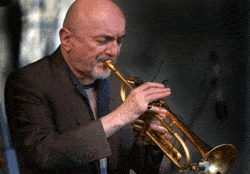
It will remain open at Hoover Square’s Centrum Artystsycznego Fabryka Trzciny until July 26. The displayed photos and documents chronicle the U.S. State Department’s Jazz Ambassadors program, which sent some of the greatest American jazz musicians around the world between 1950-1970, to create relationships and foster understanding through jazz.
Curated by Dr. Curtis Sandberg, Meridian International Center’s Vice President for the Arts, and jazz diplomacy historian Professor Penny M. Von Eschen, this exhibit draws from international archival materials. The Polish edition of the exhibit is sponsored by the U.S. Embassy in Warsaw and includes photos taken by Polish photographer Marek Karewicz, which highlight the long-standing musical relationship between the two nations.
International jazz superstar, Polish trumpeter Tomasz Stanko, performed at grand opening of the Warsaw exhibit. At the request of the Embassy, he and his Quartet played the music of Stanko’s former musical cohort, legendary Polish jazzman Krzysztof Komeda (1931-1969). During his short lifetime, Komeda, whose influences ranged from Count Basie to Chopin, led the jazz revolution that was happening in Poland.

Tomasz Stańko performs in Hoover Square in Warsaw.
Photo by Zygmunt Druzbicki, courtesy of poland.usembassy.gov
(see photo gallery of event)
Jazz music, like the Jazz Ambassadors themselves, was able to permeate the Iron Curtain in a way that nothing else could, and it left its mark on Poles:
Stanko told one of Polish dailies that the memorable concert of the Dave Brubeck Quartet in Warsaw in 1958 made a lasting impression on him. ‘It was the first time Poles could listen to modern American jazz in a live performance’, he said. [Polskie Radio, “Jazz diplomacy,” 29 June 2009]
Another important way that American jazz was shared with Polish audiences during the Cold War was through Willis Conover’s “Jazz Hour” on the Voice of America, a U.S. government-sponsored radio station. Through these influences, listening to and playing jazz became a form of resistance in Poland, one which had a profound effect on people and even politics.*

American jazz has likewise felt the influence of Polish musicians. While visiting USC on April 15, 2005 shortly before his death, Dave Brubeck performed in Bovard Auditorium. During the concert, this American jazz legend stopped to speak only once, and what he spoke of was his experience playing jazz in Poland. He described the enthusiasm of the audiences and the musicianship and passion of Polish jazz players with deep respect, a meaningful recommendation coming from such ground-breaking musician.
* For more about the history of jazz in Poland, read “Krzysztof Komeda: Poet of the Piano” on allaboutjazz.com or “Polish Jazz – Freedom at Last” on polishjazz.com.
[Sources: poland.usembassy.gov, polskieradio.pl]
_______________________________________________________
Main Source:
Polish Music Newsletter
July 2009, Vol. 15, No. 7. ISSN 1098-9188. Published monthly.
Los Angeles: Polish Music Center, University of Southern California
http://www.usc.edu/dept/polish_music/news/july09.html
